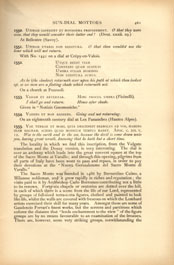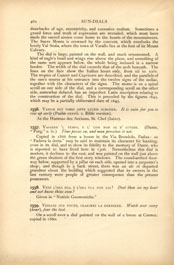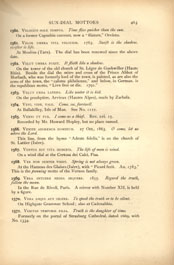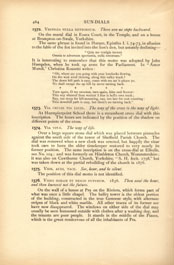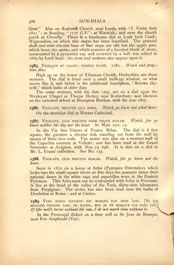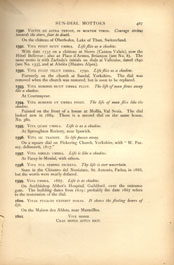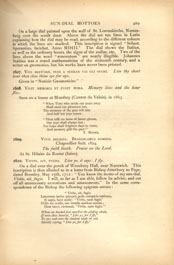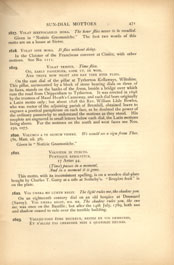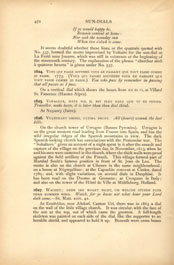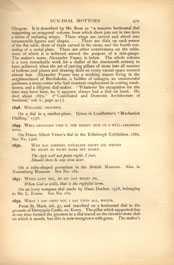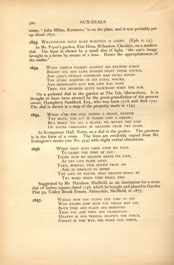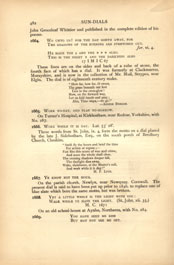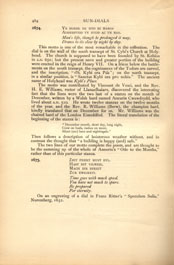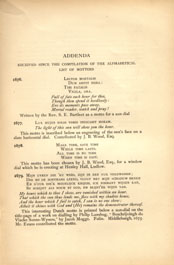Sun-Dial Mottoes (continued.)
| 1550. | UTINAM SAPERENT ET NOVISSIMA PROVIDERENT. O that they were wise, that they would consider their latter end! (Deut. xxxii. 29.) At Bellentre (Savoy). |
||||
| 1551. | UTINAM UTARIS NON REDITURA. O that thou wouldst use the hour which will not return. With No. 1441 on a dial at Crépy-en-Valois. |
||||
| 1552. | UTQUE REDIT VIAM As he (the shadow) returneth ever upon his path at which thou lookest up, so we men are a fleeting shade which returneth not. On a church at Pozzuoli. |
||||
| 1553. |
Given in "Notizie Gnomoniche." |
||||
| 1554. | VADENS ET NON
REDIENS.
On an eighteenth century dial at Les Pananches (Hautes Alpes). |
||||
| 1555. | VAE TERRAE ET MARI, QUIA DESCENDIT
DIABOLUS AD VOS, HABENS
IRAM MAGNAM, SCIENS QUOD MODICUM TEMPUS HABET.
APOC. C. XII. V. 12.
The locality in which we find this inscription, from the Vulgate translation and the Douay version, is very interesting. The dial is over an archway which leads into the great convent square at the top of the Sacro Monte at Varallo; and through this opening, pilgrims from all parts of Italy have been wont to pass and repass, in order to pay their devotions at the "Nuova Gerusalemme del Sacro Monte di Varallo." The Sacro Monte was founded in 1486 by Bernardino Caimo, a Milanese nobleman, and it grew rapidly in riches and reputation; the visits paid to it by Archbishop Carlo Borromeo contributing not a little to its renown. Forty-six chapels or oratories are dotted over the hill, in each of which there is a scene from the life of our Lord, represented by groups of full-sized terra-cotta figures, clothed and painted to look like life, whilst the walls are covered with frescoes on which the Lombard artists exercised their skill for many years. Amongst these are some of Gaudenzio Ferrari's finest works, but the screens and partitions which enforce the distance that "lends enchantment to the view" of the figure groups are by no means favourable to an examination of the frescoes. There are, however, some very striking groups, notwithstanding the |
drawbacks of age, eccentricity, and excessive realism. Sometimes a grand force and truth of expression are revealed, which must have made the sacred scene come home to the hearts of the mountaineers. The Sacro Monte is crowned by the convent, which overlooks the lovely Val Sesia, where the town of Varallo lies at the foor of its Mount Calvary. The dial is large, painted on the wall, and much ornamented. A kind of eagle's head and wings rise above the plane, and something of the same sort appears below, the whole being inclosed in a narrow border. The width of the dial exceeds that of the arch beneath. The lines on the face show the Italian hours only, from xii to xxiv. The tropics of Cancer and Capricorn are described, and the parallels of the sun's course at his entrance into the twelve signs of the zodiac, together with the characters of the signs. The motto is on a spiral scroll on one side of the dial, and a corresponding scroll on the other side, somewhat defaced, has an imperfect Latin inscription relating to the construction of the dial. This is preceded by the figures -645, which may be a partially obliterated date of 1645. |
|
| 1556. | VANUM EST VOBIS ANTE LUCEM SURGERE. It is vain for you to rise up early (Psalm cxxvii. 2, Bible version). At the Hameau des Arcisses, St. Chef (Isère). |
| 1557. | VASSENE 'L TEMPO, E L' UOM NON SE N' AVVEDE. (Dante, "Purg." c. iv.) Time passes on, and man perceives it not. Copied in 1866 from a house in the Via Brondolo, Padua: so "Padova la dotta" may be said to maintain its character for learning, even in its dial, and to show its fidelity to the memory of Dante, who is reported to have lived here in 1306. Nevertheless this dial is modern, it declines to the east, and was painted on the wall just above the green shutters of the first story windows. The round-arched doorway below, supported by a pillar on each side, opened into a carpenter's shop; and though in a back street, there was an air of departed grandeur about the building which suggested that its owners in the last century were people of greater consequence than the present possessors. |
| 1558. | VEDI L'ORA MIA, E L'ORA TUA NON SAI? Dost thou see my hour and not know thine own? Given in "Notizie Gnomoniche." |
| 1559. | VEILLEZ SUR TOUTE, CRAIGNEZ LA DERNIÈRE. Watch over every (hour), fear the last. On a scroll over a dial painted on the wall of a house at Cannes; copied in 1860. |
| 1560. | VELOCIUS SOLE TEMPUS. Time flies quicker than the sun. On a former Capuchin convent, now a "filature," Orvieto. |
| 1561. | VELOX UMBRA VITA VELOCIOR. 1763. Swift is the shadow, swifter is life. At Moulins (Tarn). The dial has been renewed since the above date. |
| 1562. | VELUT UMBRA FUGIT. It flieth like a shadow. On the tower of the old church of St. Léger de Guebwiller (Haute Rhin). Beside the dial the mitre and cross of the Prince Abbot of Murbach, who was formerly lord of the town, is painted, as are also the arms of the town, the "calotte plébéienne," and below, in German, is the republican motto, "Live free or die. 1791." |
| 1563. | VELUT UNDA LATENS. Like water it is hid. On the presbytère, Arvieux (Hautes Alpes), made by Zarbula. |
| 1564. | VENI, VIDE, VALE. Come, see, farewell. At Ballakilley, Isle of Man. See No. 1122. |
| 1565. | VENIO UT FUR. I come as a thief. Rev. xvi. 15. Recorded by Mr. Howard Hopley, but no place named. |
| 1566. | VENITE ADOREMUS DOMINUM. 27 Oct., 1863. O come, let us adore the lord. This line, from the hymn "Adeste fidelis," is on the church of St. Lattier (Isère). |
| 1567. | VENTUS EST VITA HOMINIS. The life of man is wind. On a wind dial at the Certosa dei Calci, Pisa. |
| 1568. | VER NON SEMPER VIRET. Spring is not always green. At the Hameau des Glaises (Isère), with "Picard fecit. An. 1783." This is the punning motto of the Vernon family. |
| 1569. | VERA INTUERE MEDIA SEQUERE. 1855. Regard the truth, follow the mean. In the Rue de Rivoli, Paris. A mirror with Number XII. is held by a figure. |
| 1570. | VERA LOQUI AUT SILERE. To speak the truth or to be silent. On Highgate Grammar School; also at Cadenabbia. |
| 1571. | VERITAS TEMPORIS FILIA. Truth is the daughter of time. Formerly on the portal of Strasburg Cathedral, dated 1669, with No. 1334. |
| 1572. | VESTIGIA NULLA RETRORSUM. There are no steps backward. On the mural dial in Essex Court, in the Temple, and on a house at Brompton-on-Swale, Yorkshire. The same phrase is found in Horace, Epistles I. i. 74-75, in allusion to the fable of the fox invited into the lion's den, but astutely declining – "Quia me vestigia terrent
It is interesting to remember that this motto was adopted by John Hampden, when he took up arms for the Parliament. In "Amor Mundi," Christina Rossetti writes:
"Oh,
where are you going with your lovelocks flowing,
* * * * *
Turn
again, O my sweetest, turn again, false and fleetest:
|
| 1573. | VIA CRUCIS VIA LUCIS. The way of the cross is the way of light. At Hurstpierpoint School there is a recumbent cross dial with this inscription. The hours are indicated by the position of the shadow on different points of the cross. |
| 1574. | VIA VITÆ. The way of life. Over a large square stone dial which was placed between pinnacles against the south side of the tower of Sheffield Parish Church. The dial was removed when a new clock was erected, but happily the vicar took care to have the older timekeeper restored to very nearly its former position. The same inscription is on the cross-dial at Elleslie, see No. 104; and was formerly on Himbleton Church, Worcestershire; it was also on Cawthorne Church, Yorkshire, "S. H. fecit. 1798," but was taken down at the partial rebuilding of the church in 1876. |
| 1575. | VIDE, AUDI, TACE. See, hear, and be silent. The position of this dial motto is not identified. |
| 1576. | VIDES HORAM ET NESCIS FUTURUM. 1836. Thou seest the hour, and thou knowest not the future. On the wall of a house at Pra on the Riviera, which forms part of what was once a little chapel. The belfry tower is the oldest portion of the building, constructed in the true Genoese style, with alternate stripes of black and white marble. All other traces of its former use have now disappeared. The windows on either side if the dial may usually be seen festooned outside with clothes after a washing day, and the tenants are poor people. It stands in the middle of the Piazza, which is the great rendezvous of all the inhabitants of Pra. |

[Full Image]
BELFRY AT PRA.
| 1577. | VIDES HORAM NESCIS HORAM. 1853. Thou seest the hour, thou knowest not the hour. Over the door of the church at Alassio. |
| 1578. | VIDES PRÆSENTEM FUTURUM COGITA UTRINSECUS REGIMUR. Thou seest the present hour, think on that which cometh, from both sides are we ruled. At the Cloître des Jacobins, Rue St. Dominique, Paris. |
| 1579. | VIDETE VIGILATE ET ORATE NESCITIS ENIM DIEM NEQUE HORAM. Take heed, watch and pray, for ye know neither the day not the hour. – St. Mark, xiii. 33: St. Matt. xxv. 13. Over the south door of the Frauen Kirche at Munich. The dial is very large and handsome, painted on a ground of blue with gold stars. A small seated figure in the centre of a glory of golden rays holds the gnomon, and a flying angel on each side bears up the scroll on which the hours are marked. The dial seems to date from the seventeenth century. |
| 1580. | VIDI NIHIL PERMANERE SUB SOLE. I saw there was no profit under the sun. – Eccles. ii. II. At Cividale, Friuli. |
| 1581. | VIGET QUODCUMQUE VIDET. What he looks upon flourishes. At St. Jean de Grosbec, near Aups (Var). |
| 1582. | VIGILA, ORAQUE; TEMPUS FUGIT. Watch and pray; time flies. On a buttress of the south transept of the parish church, Leighton Buzzard. With others. See No. 101. |
| 1583. | VIGILARE ET ORARE TEMPUS DIRIGIT. To watch and pray, time ordains. Over the porch of Harewood Church, near Leeds. "Robert Smith fecit 1751." is engraved on the plate. |
| 1584. | VIGILATE ET ORATE. Watch and pray. On Bridges' Almshouses, Thames Ditton, dated 1720 (the date of the building) and 1746; below is inscribed "Ex dono Henrici Bridges, |
| Gent." Also on Rothwell Church, near Leeds, with "I. Verity fecit 1821"; at Reading, "1727 G.P."; at Warwick; and over the church porch at Clovelly. There is a handsome dial at Loch Inch Castle, Wigtonshire, on which this motto has been inscribed. The graceful shaft and wide circular base of four steps are old, but the upper part, which bears the motto, and which consists of a facetted block of stone, surmounted by a pyramidal cap and crowned by a ball, was added in 1889 by Lord Stair: his crest and mottoes also appear upon it. | |
| 1585. | VIGILATE ET ORATE; TEMPUS FUGIT. 1781 . Watch and pray; time flies. High up on the tower of Ellastone Church, Derbyshire, are these mottoes. The dial is fixed over a small built-up window, or what seems like it, and below is the additional inscription, "Knowe thyselfe," which looks of older date. The same mottoes, with the date 1797, are on a dial upon the Wesleyan Chapel at Thorpe Hesley, near Rotherham; and likewise on the endowed school at Brampton Bierlow, with the date 1807. |
| 1586. | VIGILATE, NESCITIS QUA HORA. Watch, ye know not what hour. On the meridian dial at Nevers Cathedral. |
| 1587. | VIGILATE, QUIA NESCITIS DIEM NEQUE HORAM. Watch, for ye know neither the day nor the hour. St. Matt. xxv. 13. In the Via San Vittore al Teatro, Milan. The dial is 8 feet square, the gnomon a circular disk standing out from the wall by means of three iron rods. The motto was also on a western wall of the Capuchin convent at Velletri; and has been read at the Grand Séminaire at Avignon, with Nos. 75, 698. It is also on a dial in Mr. L. Evans' collection. See No. 135. |
| 1588. | VIGILATE, QUIA NESCITIS HORAM. Watch, for ye know not the hour. Seen in 1870 on a house at Arles (Pyrenées Orientales), which looks into the small square where on fête days the peasants dance their national dance in the white caps and espartillos worn in the Eastern Pyrenees. This Arles must not be confounded with Arles in Provence. It lies at the head of the valley of the Tech, thirty-nine kilometres from Perpignan. The motto has also been read near the baths of Diocletian at Rome; and at Cimiez. |
| 1589. | VIRO SENSO SOULEOU IOU MARQUI PAR SENS 'LOU. [SI (LE MOULIN) TOURNE SANS LE SOLIEL, MOI JE NE MARQUE PAS SANS LUI.] If (the mill) turns without the sun, I do not mark time without it. In the Provençal dialect on a flour mill at St Jean de Bresque, near Fox Amphoule (Var). |
| 1590. | VIRTUS AD ASTRA TENDIT, IN MORTEM TIMOR. Courage strives towards the stars, fear to death. On the château of Oberhofen, Lake of Thun, Switzerland. |
| 1591. | VITA FUGIT SICUT UMBRA. Life flies as a shadow. With date 1732 on a château at Sierre (Canton Valais), now the Hôtel Bellevue; also at Place d'Armes, Briançon (see No. 8). The same motto is with Zarbula's initials on dials at Vallouise, dated 1840 (see No. 133), and at Abriès (Hautes Alpes). |
| 1592. | VITA FUGIT VELUT UMBRA. 1790. Life flies as a shadow. Formerly on the church at Sandal, Yorkshire. The dial was removed when the church was restored, but is soon to be replaced. |
| 1593. | VITA HOMINIS SICUT UMBRA FLUIT. The life of man flows away like a shadow. At Courmayeur. |
| 1594. | VITA HOMINIS UT UMBRA FUGIT. The life of man flies like the shadow. Painted on the front of a house at Mollia, Val Sesia. The dial looked new in 1889. There is a second dial on the same house, No. 380. |
| 1595. | VITA QUASI UMBRA. Life is a shadow. At Sproughton Rectory, near Ipswich. |
| 1596. | VITA SIC TRANSIT. So life passes away. On a square dial on Pickering Church, Yorkshire, with "W. Putsey, delineavit, 1817." |
| 1597. | VITA SIMILIS UMBRA. Life is like a shadow. At Paray-le-Monial, with others. |
| 1598. | VITA TUA SEMPER INCERTA. Thy life is ever uncertain. Seen in the Chiostro del Noviziato, St. Antonio, Padua, in 1888, but the words were nearly defaced. |
| 1599. | VITA UMBRA. 1867. Life is as shadow. On Archbishop Abbot's Hospital, Guildford, over the entrance gate. The building dates from 1619; probably the date 1867 refers to the restoration of the dial. |
| 1600. | VITAE FUGACES EXHIBET HORAS. It shows the fleeting hours of life. On the Maison des Ablets, near Marseilles. |
| 1601. | VIVE HODIE
CRAS MINUS APTUS ERIT. |
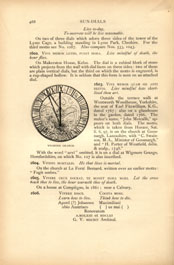
[Full Image]
WIGMORE GRANGE.
|
Live to-day, On two of three dials which adorn three sides of the tower of the Lyme Cage, a building standing in Lyme Park, Cheshire. For the third motto see No. 1087. Also compare Nos. 553, 1043. |
||||
| 1602. | VIVE MEMOR LETHI, FUGIT HORA. Live mindful of death, the hour flies. On Makerston House, Kelso. The dial is a cubical block of stone which projects from the wall with dial faces on three sides: two of these are plain vertical dials, but the third on which the motto is engraved, is a cup-shaped hollow. It is seldom that this form is seen on an attached dial. |
|||
| 1603. | VIVE MEMOR QUAM SIS AEVI BREVIS. Live mindful how short-lived thou art. Outside the terrace walk at Wentworth Woodhouse, Yorkshire, the seat of Earl Fitzwilliam, K.G., dated 1767; also on a glasshouse in the garden, dated 1766. The maker's name, "John Metcalfe," appears on both dials. The motto, which is taken from Horace, Sat. ii. 6, 97, is on the church at Goosnargh, Lancashire, with "C. Swainson, M.A., Minister of Goosnargh," and "H. Porter of Westfield, delin. & sculp., 1748." With the word "aevi" omitted, it is on a dial at Wigmore Grange, Herefordshire, on which No. 127 is also inscribed. |
|||
| 1604. | VIVENS MORTALIS. He that lives is mortal. On the church at La Ferté Bernard, written over an earlier motto: "Fugit umbra." |
|||
| 1605. | VIVERE CRUX DOCEAT, TE MONET HORA MORI. Let the cross teach thee to live, the hour warneth thee of death. On a house at Compiègne, in 1861; near a Calvary. |
|||
| 1606. |
|
On a large dial painted upon the wall of St. Lorenzkirche, Nuremberg, over the south door. Above the dial are ten lines in Latin explaining how the dial may be read, according to the different colours in which the lines are marked. This inscription is signed "Sebast. Sperantius, faciebat, Anno MDIII." The dial shows the Italian, as well as the ordinary hours, the signs of the zodiac, etc. Two of the lines above the word "renovatum" are nearly illegible. Johannes Stabius was a noted mathematician of the sixteenth century, and a writer on gnomonics, but his works have never been printed. |
|
| 1607. | VIVI BREV'ORE, INDI A SERRAR VAI GLI OCCHI. Live thy short hour then close thine eye for aye. Given in "Notizie Gnomoniche." |
| 1608. | VIVIT MEMORIA ET FUGIT HORA. Memory lives and the hour flies. Seen on a house at Monthey (Canton du Valais), in 1863.
|
| 1609. | VIVIT RELIGIO. BENEDICAMUS DOMINO.
At St. Hilaire du Rosier (Isère). |
| 1610. | VIVITE, AIT, FUGIO. Live ye, it says: I fly. On a dial over the porch of Wrenbury Hall, near Nantwich. This inscription is thus alluded to in a letter from Bishop Atterbury to Pope, dated Bromley, May 25th, 1712: "You know the motto of my sun-dial, Vivite, ait, fugio. I will, as far as I am able, follow its advice, and cut off all unnecessary avocations and amusements." In the same correspondence of the Bishop the following epigram occurs:
|
The dial was probably a mural one on the ancient moated palace of the Bishops of Rochester, at Bromley, which was pulled down by Bishop Thomas in 1774. The building which he substituted has ceased to be an episcopal residence. VIVITE, FUGIO, Live ye, I fly, with the date 1774, is on the steeple of St. Cuthbert's, commonly called the West Kirk, Edinburgh. VIVITE, ECCE FUGIO, Live ye, behold I fly! 1712, is on the church of Kirkby Overblow, Yorkshire. |
|
| 1611. | VIVO TRA VITI MA IL MIO CORE INGOMBRA
Midst vines I dwell, and yet my heart o'erweighed,
In the sacristy of the church of the Frari at Venice there is an old clock, having a wooden frame elaborately carved with figures and devices. One of these represents a man in armour standing amidst vines, and holding a sun-dial, above which the foregoing motto is inscribed. The four corners of the clock represent Childhood, Youth, Manhood, and Old Age, together with the Four Seasons, and the four winds or cardinal points. The setting sun, and waning moon, a skeleton, an owl, and various other emblems are also represented, and an explanation of the carving written on parchment is affixed to the door. The frame was carved out of a single piece of cypress wood, by Francesco Pianta, A.D. 1500. |
| 1612. | VIX ORIMUR ET OCCIDIMUS. Scarce do we arise, and we have set. Formerly in a court at St. Géneviève, Paris. |
| 1613. | VOICI VOTRE HEURE. Behold your hour. Read near Geneva; and at Les Hières (Haute Alpes). |
| 1614. | VOLA L'ORA ED IL TEMPO ANCORA. The hour flies and time yet more. At Castel Nuovo, near Bormida. |
| 1615. | VOLANO L'ORE, I GIORNI, GL'ANNI, E I MESI (Petrarch).
Given in "Notizie Gnomoniche." |
| 1616. | VOLAT IRREPARABILE TEMPUS Time flies, never to be retrieved; at length there will be nothing beneath the sun. At La Buiserate (Isère). The first line was formerly at St. Apollinare in Classe, Ravenna; and also on an engraving of a sun-dial in "Gnomonice de Solariis," 1572, by B. Schultz, with other mottoes. |
| 1617. | VOLAT IRREVOCABILIS HORA. The hour flies never to be recalled. Given in "Notizie Gnomoniche." The first two words of this motto are on a house at Sierre. |
| 1618. | VOLAT SINE MORA. It flies without delay. In the Cloister of the Franciscan convent at Cimiez, with other mottoes. See No. 1111. |
| 1619. | VOLAT TEMPUS. Time Flies. OH, EARLY PASSENGER, LOOK UP, BE WISE, On the east dial of the pillar at Tytherton Kellaways, Wiltshire. This pillar, surmounted by a block of stone bearing dials on three of its faces, stands on the banks of the Avon, beside a bridge over which runs the road from Chippenham to Tytherton. It was erected in 1698 by the trustees of Maud Heath's Causeway, and each dial bore originally a Latin motto only; but about 1828 the Rev. William Lisle Bowles, who was rector of the adjoining parish of Bremhill, obtained leave to engrave a poetical paraphrase on each face, as he doubted the power of the ordinary passers-by to understand the mottoes as they stood. His couplets are engraved in small letters below each dial, the Latin mottoes being above. For the mottoes on the south and west faces see Nos. 250, 1077. |
| 1620. | VOLUMUS A TE SIGNUM VIDERE. We would see a sign from Thee. (St. Matt. xii. 38). Given in "Notizie Gnomoniche." |
| 1621. | VOLVITUR IN PUNCTO.
(Time) passes in a moment,
This motto, with its inconsistent spelling, is on a wooden dial-plate bought by Charles T. Gatty at a sale at Sotheby's. "Bruyère fecit" is on the plate. |
| 1622. | VOS UMBRA ME LUMEN REGIT. The light rules me, the shadow you. On an eighteeth century dial on an old hospice at Doussard (Savoy). VOS UMBRA REGIT, SOL ME, The shadow rules you, the sun me, was once on the Bastille; but after the 14th July, 1789, both sun and shadow ceased to rule over the terrible building. |
| 1623. | VOULEZ-VOUS ÊTRE HEUREUX,
RESTEZ EN VOS DEMEURES,
|
It seems doubtful whether these lines, or the quatrain quoted with No. 537, formed the motto improvised by Voltaire for the sun-dial at La Ferté sous Jouarre, which was still in existence at the beginning of the nineteenth century. The explanation of the phrase "chercher midi à quatorze heures" is given under No. 537. |
||
| 1624. | VOVS QUI PASSÉ
SOVVENÉ VOVS AN PASSANT
QVE TOVT PASSE COMME JE PASSE. 1773.
(VOUS QUI PASSEZ SOUVENEZ
VOUS EN PASSANT QUE TOUT PASSE COMME JE PASSE.)
On a vertical dial which shows the hours from XII to VI, at Villard St. Pancrace (Hautes Alpes). |
|
| 1625. | VOYAGEUR, HÂTE TOI, IL EST PLUS TARD QUE TU NE PENSES. Traveller, make haste, it is later than thou dost think. At Noyarey (Isère). |
|
| 1626. | VULNERANT OMNES, ULTIMA NECAT. All (hours) wound, the last kills. On the church tower of Urrugne (Basses Pyrenées). Urrugne is on the great western road leading from France into Spain, and has the wild irregular ridges of the Spanish mountains in view. The dark Spanish-looking church has associations with the Peninsular war. The "Subaltern" gives an account of a night spent in it after the assault and capture of the village on the previous day, in November, 1813, when he and his men were cantoned in the church, where the thick walls were proof against the field artillery of the French. This village formed part of Marshal Soult's famous position in front of St. Jean de Luz. The motto is also on the church at Ciboure in the same neighbourhood; on a house at Négrepélisse; at the Capuchin convent at Cimiez, dated 1789; and, with slight variations, on several dials in Dauphiné. It has been read on the Duomo at Grosseto; at Crespano in Italy; and also on the tower of the Hôtel de Ville at Middleburg, Holland. |
|
| 1627. | WACHET; DENN IHR WISSET NICHT, UM WELCHE STUNDE EUER HERR KOMMEN WIRD.
At Erstfelden, near Altdorf, Canton Uri, there was in 1863 a dial on the wall of the little village church. It was circular, with the face of the sun at the top, out of which came the gnomon. A full-length skeleton was painted on each side of the dial, like the supporter to an heraldic shield, and appeared to hold it up. Beneath were cross bones |
and some words which had become defaced and illegible. The motto was above the dial. |
|
| 1628. |
Engraved on the outside of a goblet-shaped dial in the Nuremberg Museum; made of silver or of copper gilt. The gnomon is attached to the edge of the brim, and its shadow falls upon the numerals which are within the cup. The name of the maker, "Marcus Purman, Monach: fecit," and the date 1590, also appear on the dial. |
| 1629. | WASTE NO TIME. This motto appears twice on a dial at the House of Mercy, Horbury, near Wakefield, which was brought there from Thornhill Churchyard. It is a cross dial, the gnomon being in the shape of a Greek cross, round the base of which this motto and two others (see Nos. 278, 921) are inscribed. |
| 1630. | WATCH. St. Mark, xiii. 37. Inscribed by the Rev. E. Z. Lyttel on his dial at Woodville, Burton-on-Trent. |
| 1631. | WATCH AND PRAY. 1735. On the south wall of Alwalton Church, Huntingdonshire; and on the church porch of Terrington St. Clement, Norfolk, with the names of the churchwardens, "Mudd and Dewson," but no date. It is also on Laithkirk Church, Yorkshire. It is with No. 1419 on the Church at Isleworth, which dates from 1705; the plate is surmounted by a figure of Time with his scythe, and has the hours marked for several distant places, such as Jerusalem, Moscow, etc. |
| 1632. | WATCH AND PRAY Over the door of a shop at Leighton Buzzard. The gnomon is surrounded with rays, and below is a small dim landscape view with trees and a windmill. Also on a handsome dial erected in 1889 on the south wall of the western tower of St. Mary's Church, Colebrook, Devon. The dial was the gift of Mr. Charles Turner, of Sydenham, and was designed and executed by Mr. Harry Hems. Colebrook Church dates from the fifteenth century, and contains a mediæval fireplace in the north wall, which is almost unique; and some very quaint epitaphs |
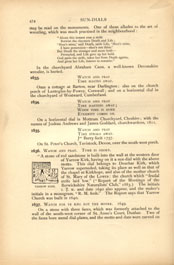
[Full Image]
YARROW KIRK.
may be read on the monuments. One of these alludes to the art of wrestling, which was much practiced in the neighbourhood: "About this instant rose a strife In the churchyard Abraham Cann, a well-known Devonshire wrestler, is buried. |
|
| 1633. | WATCH AND PRAY Once a cottage at Barton, near Darlington; also on the church porch of Lanteglos-by-Fowey, Cornwall; and on a horizontal dial in the churchyard of Westward, Cumberland. |
| 1634. | WATCH AND PRAY On a horizontal dial in Mottram Churchyard, Cheshire; with the names of Joshua Andrews and James Goddard, churchwardens, 1811. |
| 1635. | WATCH AND PRAY On St. Peter's Church, Tavistock, Devon, over the south-west porch. |
| 1636. | WATCH AND PRAY. TYME IS SHORT. "A stone of red sandstone is built into the wall at the western door of Yarrow Kirk, having on it a sun-dial with the above motto. This dial belongs to Deuchar Kirk, which Yarrow superseded, taking its place as well as that of the chapel at Kirkhope, and also of the mother church of St. Mary of the Lowes: the church which "feudal strife laid low," ("Report of the Meetings of the Berwickshire Naturalists' Club," 1883.) The initials I. MF. M. and date 1640 also appear, and the maker's initials in a monogram, "R. M. fecit." The Report says that Yarrow Church was built in 1640. |
| 1637. | WATCH FOR YE KNO NOT THE HOVRE. 1649. On a stone with three faces, which was formerly attached to the wall of the south-west corner of St. Anne's Court, Dunbar. Two of the faces bore metal dial-plates, and the motto and date were carved on |
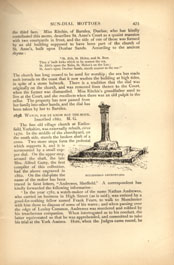
[Full Image]
ECCLESFIELD CHURCHYARD.
the third face. Miss Ritchie, of Barnlea, Dunbar, who has kindly contributed this motto, describes St. Anne's Court as a quaint mansion with two courtyards in front, and the side of one of these was formed by an old building supposed to have been part of the church of St. Anne's, built upon Dunbar Sands. According to the ancient thyme: "St. Abb, St. Helen, and St. Bees The church has long ceased to be used for worship; the sea has made such inroads on the coast that it now washes the building at high tides in spite of a stone bulwark. There is a tradition that the dial was originally on the church, and was removed from thence to the Court, when the former was dismantled. Miss Ritchie's grandfather used to live at the Court, and she recollects when there was an old pulpit in the cellar. The property has now passed from her family into other hands, and the dial has been taken by her to Barnlea. |
|
| 1638. |
WATCH, FOR YE KNOW NOT THE HOUR. The fine old village church at Ecclesfield, Yorkshire, was externally rebuilt, circa 1470. In the middle of the churchyard, on the south side, stands the broken shaft of a cross. Two stone steps form the pedestal which supports it, and it is surmounted by a small copper dial. On the upper step, around the shaft, the late Mrs. Alfred Gatty, the first compiler of this collection, had the above engraved in 1862. On the dial-plate the name of the maker has been traced in faint letters, "Andrewes, Sheffield." A correspondent has kindly forwarded the following information: "In the year 1782, a watch-maker of the name Nathan Andrewes, who carried on business in High Street (as is said), was enticed by a good-for-nothing fellow named Frank Fearn, to walk to Manchester with him there to dispose of some of his wares; and when passing over the edge of Loxley Common, Andrewes was murdered and robbed by his treacherous companion. When interrogated as to his conduct, the latter equivocated so that he was apprehended, and committed to take his trial at the York Assizes. Here, when the Judges came round, he |
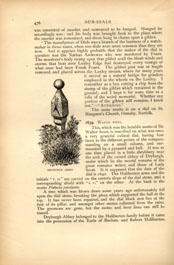
[Full Image]
DRYBURGH ABBEY.
was convicted of murder, and sentenced to be hanged. Hanged he accordingly was; and his body was brought back to the place where the murder was committed, and there hung in chains upon a gibbet. "The manufacture of Dials was a branch of the business of a watch-maker in those times, when sun-dials were more common than they are now. And it appears highly probable that the maker of the dial in question was the Nathan Andrewes who was murdered by Fearn. The murderer's body swung upon that gibbet until the bleak winds and storms that beat over Loxley Edge had destroyed every vestige of what once had been Frank Fearn. The gibbet post was at length removed, and placed across the Loxley stream, where for many years it served as a natural bridge for grinders employed in the wheels on the Loxley. I remember as a boy cutting a chip from the stump of the gibbet which remained in the ground; and I kept it for some time as a relic of the weird memorial. Whether any portion of the gibbet still remains, I know not." – "AUTOLYCUS." The same motto is on a dial on St. Margaret's Church, Ormsby, Norfolk. |
|
| 1639. | WATCH WEEL. This, which was the heraldic motto of Sir Walter Scott, is inscribed on what was once a very graceful cubical dial, having four faces to the different points of the compass, standing on a small column, and surmounted by a pyramid and ball. It was at one time placed in a little shrubbery near the arch of the ruined abbey of Dryburgh, under which lie the mortal remains of the great romance writer, and those of Lady Scott. It is supposed that the date of the dial is 1640. The Haliburton arms and the initials "T. H." are carved on the eastern slope of the dial stone, and a corresponding shield with "I. C." on the other. At the back is the motto Fiducia constante. A tree which was blown down some years ago unfortunately fell upon the dial stone, breaking the piece which supported the ball at the top. It has never been repaired, and the dial block now lies at the foot of its pillar, and amongst other stones collected from the ruins. The gnomons are gone, but the motto and hour lines can still be traced. Dryburgh Abbey belonged to the Haliburton family before it came into the possession of the Earls of Buchan, and Robert Haliburton, |
grand-uncle of Sir Walter Scott, ad settled it by will upon the poet's father, as heir in the maternal line. But this ancient patrimony was lost to the Scotts through Mr. Haliburton's commercial misadventures; "and thus," wrote Sir Walter, in his brief autobiography, "we have nothing left of Dryburgh, although my father's maternal inheritance, but the right of stretching our bones where mine may perhaps be laid ere any eye but my own glances over these pages." The collector (M.G.) sketched the dial on the 10th August, 1839, and thus wrote: "'Watch weel,' lest thieves should enter while ye sleep – |
|
| 1640. | WE ARE THE HOURS ON THE PILLAR YOU SEE,
These lines are the translation of a Latin inscription (which we have been unable to obtain) on an obelisk dial erected in 1630 in Drummond Castle Gardens by the second Earl of Perth. The shaft is covered with dial hollows of various forms, the centre and wider portion with plane dials. The architect, John Mylne, the third of the name, was the maker. The above rendering of the inscription is by Dr. William Barrack, Rector of Dollar Academy, near Stirling. There are a few more lines at the base of the pedestal, but these are quite illegible. |
| 1641. | WE MAY NOT STAY. 1782. Over the porch of Middleton Church, near Pickering. |
| 1642. | WE MUST AND SHALL ERE LONG DYALL. On a brass dial-plate formerly belonging to the Rev. Vernon Yonge, |
and given by him to be placed in the garden of Blackden House, near Crewe, from whence it has unfortunately disappeared. It bore the date 1647, and at the four corners were quarterings of arms belonging to the Yonges of Charnes, Staffordshire, and the family motto, Et servata fides perfectus amorque ditabunt. |
|
| 1643. | WE MUST DIE ALL. On the church porch, Writhlington, Somerset; also on the tower of Redbourne co. Lincoln, with the last two words transposed, and the date 1780. "We must – " may be seen in the engraving of Hogarth's picture of "Chairing the Member," substituted for the motto in the painting, "Pulvis et umbra sumus." The engraver thought he knew better than the artist what was fitting. |
| 1644. | WE RESEMBLE THE SHADOW. 1812. On a large dial of elaborate workmanship, over the porch of Wragby Church, Yorkshire. The church stands within the walls of Nostell Park, near the site of the Priory. |
| 1645. | WE SHALL – (scil. Dial, i.e.,die-all). This somewhat cumbrous joke is not uncommon. It may be read in Buxted Churchyard, Sussex, where it is inscribed on an old and rather elaborately engraved horizontal dial dated 1693. It was until 1858 on a dial over the south porch of Bromsgrove Church, Worcestershire, the inscription being in Old English characters. The dial was removed when the church was "restored." Wee shall – has been read on a house at Easton, near Stamford; and at Kedleston, in Derbyshire. An old story connected with this quaint conceit is, that a certain pious cleric, who had seen the inscription "We must" on a sun-dial, and ascertained how the "die all" to conclude the sentence was obtained, ordered the words "we must" to be inscribed on the clock face of his church! It is a very old witticism. Sylvanus Morgan finishes his work, "Horologiographia Optica," published in 1652, with these words: "So that as I began with the Diall of Life, So we shall Dye all. For Mors ultima linea." |
| 1646. | WE SHALL DIE ALL. 1724. On St. Eval Church, Cornwall; also over the door of Mr. Emmerson's house, Walgrave, Northamptonshire, the dial being probably of the last century. It was formerly on a building in the Potter Row, Edinburgh, known as the "General's entry." See Sir D. Wilson's "Memorials of Edinburgh," chap. ii., p. 125. |
| 1647. | WE SPEND OUR YEARS AS A TALE THAT IS TOLD. Ps. xc. 9. This text with No. 528, is cut on a dial column nearly 10 feet high, which was erected in 1840 in the garden at Bredisholm, near |
Glasgow. It is described by Mr. Ross as "a massive horizontal dial supporting an octagonal column, from which there juts out in two tiers a series of radiating wings. These wings are carved and sliced into innumerable figures and shapes,... There are dials on each corner of the flat table, three of them carved in the stone, and the fourth consisting of a metal plate. There are other contrivances on the table, some of which it is believed served the purpose of a rain-gauge. The maker's name, Alexander Fraser, is below. The whole column is a very remarkable work for a dialler of the nineteenth century to have achieved, when the art of carving pillars of stone into all manner of hollows and planes and drawing dials on every vacant space seemed almost lost. Alexander Fraser was a working mason living in the neighbourhood of Bredisholm, a builder of cottages, an unsuccessful gardener, a stone-cutter who had constant employment in cutting tombstones, and a diligent dial-maker. "Whatever his occupation for the time may have been, he, it appears, always had a dial on hand. He died about 1870." ("Castellated and Domestic Architecture of Scotland," vol. v., page 417.) |
|
| 1648. | WELCOME, CHAPMEN. On a dial in a market-place. Given in Leadbetter's "Mechanick Dialling," 1756. |
| 1649. | WELL-ARRANGED TIME IS THE SUREST SIGN OF A WELL-ARRANGED MIND. On Prince Albert Victor's dial in the Edinburgh Exhibition, 1886. See No. 1306. |
| 1650. | WEN DAS SONNENS
STÖCKLEIN RECHT SOL WEISEN
The style will not point right, I fear,
On a cube-shaped portarium in the British Museum. Also in Nuremberg Museum. See No. 182. |
| 1651. | WENN GOTT WIL, SO IST DAS RECHT ZIL. When God so wills, that is the rightful term. On an ivory compass dial made by Hans Ducher, 1578, belonging to Mr. L. Evans. See No. 182. |
| 1652. | WHAT I SAY UNTO YOU I SAY UNTO ALL, WATCH. From St. Mark, xiii. 37, and inscribed on a horizontal dial in the grounds of Derryquin Castle, co. Kerry. The pillar which supports it has at one time formed the gnomon to a dial traced on the circular stone slab on which it stands, but this is now overgrown with grass. The maker's |
name, "John Milne, Kenmare," is on the plate, and it was probably put up about 1870. |
|
| 1653. | WHATSOEVER DOTH MAKE MANIFEST IS LIGHT. (Eph. v. 13.) In Mr. Fryer's garden, Elm Hirst, Wilmslow, Cheshire, on a modern dial. The hour is shown by a small disc of light, "the sun's image brought to a focus by means of a lens. Hence the appropriateness of the motto." |
| 1654. | WHEN JOSHUA FOUGHT
AGAINST HIS ENEMIES FORCE
On a pedestal dial in the garden at The Isle, Shrewsbury. It is thought to have been erected by the great-grandfather of the present owner, Humphrey Sandford, Esq., who was born 1718, and died 1791. The dial is shown in a map of the property made in 1745. |
| 1655. | WHEN O'ER THE DIAL GLIDES A SHADE, REDEEM
At Kempstone Hall, Notts, on a dial in the garden. The gnomon is in the form of a cross. The lines are evidently copied from Mr. Essington's motto (see No. 474) with slight verbal alterations. |
| 1656. | WHEN THOU DOST LOOK UPON MY FACE,
Suggested by Mr Harrison, Sheffield, as an inscription for a stone dial 18 inches square, dated 1748, which he bought and placed in Garden Plot 59, Totley Brook Estate, Abbeydale, Sheffield, in 1877. |
| 1657. | WHERE NOW YOU STAND THE TIME TO SPY
|
HERE LET US WALK WHILE WE HAVE LIGHT,
|
|
| 1658. | WHILE WE HAVE TIME From Gal. vi. 10. On the south side of the chancel, Stamfordham Church, Northumberland. |
| 1659. | WHILE YOU HAVE TIME DO GOOD. On a vertical dial made by Mr. E. C. Middleton, and placed in 1897 on his house in Stanmore Road, Birmingham. It shows the signs of the zodiac and the points of the compass as well as the hours, and has created great interest and some wonder amongst the passers-by. Some have conjectured that it had something to do with the telegraph; and others that it was "some sort of an incubator!" |
| 1660. | WHILST PHOEBUS ON ME SHINES On the Manx dial now at Barnes Lodge, King's Langley, see No. 161. |
| 1661. | WHO DULY WEIGHS THE HOURS. At Breage in Cornwall, where Mrs. Godolphin was buried. This eminent lady, whose life was written by John Evelyn, one of her most intimate friends, was a daughter of Colonel Blagge, and born in 1652. She became a maid of honour to Queen Catherine at the court of Charles II., and, in 1675, married Sidney, third son of Sir Francis Godolphin. What especially distinguished her was her pious, modest, and discreet character, whilst living at a court where Christian virtues were strange. She died in 1678, and was buried at Breage, where the Godolphin family had been settled before the Conquest. Her husband was created Earl of Godolphin, and through their great grand-daughter they were ancestors of the Duke of Leeds. |
| 1662. | WITH LOVELY PROSPECT
AND IN BALMY AIR,
Engraved on a stone beneath a dial which stands in a beautiful walk at Pine Banks Tower, Thorpe-next-Norwich. It was erected by J. O. Howard Taylor, Esq., in memory of his wife. |
| 1663. | WITH WARNING HAND I MARK TIME'S
RAPID FLIGHT
Inscription on a sun-dial for Dr. Henry J. Bowditch, written by |
John Greenleaf Whittier and published in the complete edition of his poems. |
|
| 1664. | WO UNTO US! FOR THE DAY GOETH AWAY, FOR
Jer. vi. 4.
HE MADE THE ☽
AND THE ☀ ☀ ☀ ALSO.
17 I M. I C 67 These lines are on the sides and back of a cube of stone, the fourth face of which has a dial. It was formerly at Clackmarras, Morayshire, and is now in the collection of Mr. Muil, Strypes, near Elgin. The dial is of eighteenth century make.
|
| 1665. | WORK TO-DAY, AND PLAY TO-MORROW. On Turner's Hospital, at Kirkleatham, near Redcar, Yorkshire, with No. 287. |
| 1666. | WORK WHILE IT IS DAY. Lat. 53' 28'. These words from St. John, ix. 4, form the motto on a dial placed by the late J. Sidebotham, Esq., on the south porch of Bredbury Church, Cheshire. "Swift fly the hours and brief the time |
| 1667. | YE KNOW NOT THE HOUR. On the parish church, Newlyn, near, Newquay, Cornwall. The present dial is said to have been put up prior to 1846, to replace one of blue slate which bore the same motto, but was broken. |
| 1668. | YET A
LITTLE WHILE IS THE LIGHT WITH YOU:
M. C. 1671 On an old school-house at Aynho, Northants, with No. 284. |
| 1669. | YOU HAVE SEEN ME RISE
BUT MAY NOT SEE ME SET. |
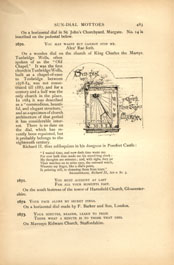
[Full Image]
SUNDIAL ON CHURCH OF KING CHARLES, MARTYR.
On a horizontal dial in St. John's Churchyard, Margate. No. 14 is inscribed on the pedestal below. |
|
| 1670. | YOU MAY WASTE BUT CANNOT STOP ME.
On a wooden dial on the church of King Charles the Martyr, Tunbridge Wells, often spoken of as the "Old Chapel." It was the first church in Tunbridge Wells, built as a chapel-of-ease to Tonbridge between 1678-84, was not consecrated till 1887, and for a century and a half was the only church in the place. In 1684 it was described as a "commodious, beautiful, and elegant structure," and as a specimen of church architecture of that period it has considerable interest. There is no date on the dial, which has recently been repainted, but it probably belongs to the eighteenth century. Richard II. thus soliloquizes in his dungeon in Pomfret Castle: "I wasted time, and now doth time waste me. |
| 1671. | YOU MUST ACCOUNT AT LAST On the south buttress of the tower of Haresfield Church, Gloucestershire. |
| 1672. | YOUR FACE ALONE MY SECRET FINDS. On a horizontal dial made by F. Barker and Son, London. |
| 1673. | YOUR MINUTES, READER,
LEARN TO PRIZE
On Mavesyn Ridware Church, Staffordshire. |
| 1674. | YR HOEDL ER HYD EI HAROS This motto is one of the most remarkable in the collection. The dial is on the wall of the south transept of St. Cybi's Church at Holyhead. The church is supposed to have been founded by St. Kebius in A.D. 650; but the present nave and greater portion of the building were erected in the reign of Henry VII. On a frieze below the battlements on the south transept, the cognizances of the Tudors are carved, and the inscription, "ST̃S, Kybi ora Pũs"; on the north transept, in a similar position, is "Sanctus Kybi ora pro nobis." The ancient name of Holyhead was Kybi's Place. The motto was contributed by Viscount de Vesci, and the Rev. H. E. Williams, rector of Llanaelhaiarn, discovered the interesting fact that the lines were the last of a stanza on the month of December, written by a Welsh bard named Aneurin Cwawdrydd, who lived about A.D. 510. He wrote twelve stanzas on the twelve months of the year, and the Rev. R. Williams (Berw), the champion bard, kindly translated that on December for us. Mr. Williams was the chaired bard of the London Eisteddfod. The literal translation of the beginning of the stanza is: "December month, short day, long night, Then follows a description of boisterous weather without, and in contrast the thought that "a building is happy (and) safe." The two lines of our motto complete the poem, and are thought to be the summing up of the whole of Aneurin's "Ode to the Months," rather than of this particular stanza. |
| 1675. |
On an engraving of a dial in Franz Ritter's "Speculum Solis." Nuremberug, 1652. |
ADDENDA
RECEIVED SINCE THE COMPILATION OF THE ALPHABETICAL LIST OF MOTTOES
| 1676. |
Written by the Rev. S. E. Bartleet as a motto for a sun-dial. |
| 1677. | LUX HUJUS SOLIS
VOBIS INDICABIT HORAM.
This motto is inscribed below an engraving of the sun's face on a slate horizontal dial. Contributed by J. B. Wood, Esq. |
| 1678. | MAKE TIME, SAVE TIME This motto has been chosen by J. B. Wood, Esq., for a window dial which he is erecting at Henley Hall, Ludlow. |
| 1679. | MIJN UYREN DIE 'KU WÈÈS, ZIJN IN EEN UUR VERDWENEN;
My
hours which to thee I show, are vanished within an hour.
This interesting Dutch motto is printed below a sun-dial on the title-page of a work on dialling by Philip Lansbug, "Beschrijvingh du Vlacke Sonne-Wysers," by Jacob Mogge. Folio. Middleburgh, 1675. Mr. Evans contributed the motto. |
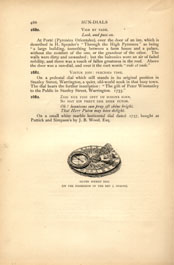
[Full Image]
SILVER POCKET DIAL
(IN THE POSSESSION OF THE REV. J. STACYE.)
| 1680. | VIDE ET VADE. At Porté (Pyrenées Orientales), over the door of an inn, which is described in H. Spender's "Through the High Pyrenees" as being "a large building, something between a farm house and a palace, without the comfort of the one, or the grandeur of the other. The walls were dirty and unwashed; but the balconies wore an air of faded nobility, and there was a touch of fallen greatness in the roof. Above the door was a sun-dial, and over it the curt words "vide et vade." |
| 1681. | VIRTUE JOIN: PRECIOUS TIME. On a pedestal dial which still stands in its original position in Stanley Street, Warrington, a quiet, old-world nook in that busy town. The dial bears the further inscription: "The gift of Peter Winstanley to the Public in Stanley Street, Warrington. 1755." |
| 1682. |
On a small white marble horizontal dial dated 1757, bought at Puttick and Simpson's by J. B. Wood, Esq. |
